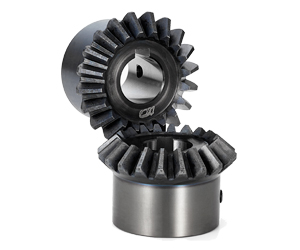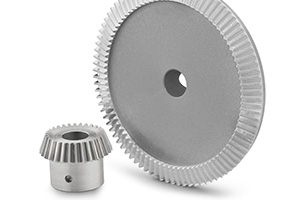Product Description
Stainless Steel Bevel Gears 90 Degree Miter Spiral Best Supplyer Forged Plastic Sintered Metal High Quanlity CHINAMFG for Test Machine Stainless Steel Bevel Gears
Application of Bevel Gears
Bevel gears are used in a wide variety of applications, including:
- Automotive: Bevel gears are used in automotive differentials, steering gears, and transmissions.
- Machine tools: Bevel gears are used in machine tools, such as lathes and milling machines, to transmit power from the motor to the cutting tool.
- Aerospace: Bevel gears are used in aerospace applications, such as jet engines and helicopters.
- Robotics: Bevel gears are used in robotics, such as robotic arms and manipulators.
- Industrial machinery: Bevel gears are used in industrial machinery, such as conveyor belts and pumps.
Bevel gears are a type of gear with teeth that are cut at an angle to the axis of rotation. This angle creates a gradual meshing of the teeth, which results in smoother operation and less noise than other types of gears, such as spur gears. Bevel gears also have a higher efficiency than spur gears, which means that they can transmit more power with less loss.
Here are some of the specific benefits of using bevel gears:
- Smoother operation: Bevel gears have a smoother operation than other types of gears, which makes them a good choice for applications where noise and vibration are a concern.
- Less noise: Bevel gears produce less noise than other types of gears, which makes them a good choice for applications where noise is a concern.
- Higher efficiency: Bevel gears have a higher efficiency than other types of gears, which means that they can transmit more power with less loss.
- Longer life: Bevel gears have a longer life than other types of gears, which makes them a good choice for applications where durability is a concern.
Bevel gears are a versatile and essential part of many machines and systems. They are used to transmit power and motion between different components, and they offer a number of advantages over other types of gears, such as smooth operation, less noise, higher efficiency, and longer life.
Here are some examples of how bevel gears are used in specific applications:
- Automotive: Bevel gears are used in automotive differentials to transmit power from the driveshaft to the wheels.
- Machine tools: Bevel gears are used in machine tools, such as lathes and milling machines, to transmit power from the motor to the cutting tool.
- Aerospace: Bevel gears are used in aerospace applications, such as jet engines and helicopters, to transmit power from the engine to the propeller or rotor.
- Robotics: Bevel gears are used in robotics, such as robotic arms and manipulators, to transmit power from the motor to the joints.
- Industrial machinery: Bevel gears are used in industrial machinery, such as conveyor belts and pumps, to transmit power from the motor to the drive shaft.
Bevel gears are a versatile and essential part of many machines and systems. They are used to transmit power and motion between different components, and they offer a number of advantages over other types of gears, such as smooth operation, less noise, higher efficiency, and longer life.
| Application: | Motor, Electric Cars, Motorcycle, Machinery, Marine, Toy, Agricultural Machinery, Car |
|---|---|
| Hardness: | Hardened Tooth Surface |
| Gear Position: | Internal Gear |
| Manufacturing Method: | Cast Gear |
| Toothed Portion Shape: | Worm Gear |
| Material: | Stainless Steel |
| Samples: |
US$ 9999/Piece
1 Piece(Min.Order) | |
|---|

What are the factors to consider when selecting miter gears for an application?
When selecting miter gears for an application, several factors need to be taken into consideration to ensure optimal performance and compatibility. Here are some key factors to consider:
1. Load Requirements:
Determine the magnitude and type of load that the miter gears will be subjected to. Consider factors such as torque, speed, and direction of rotation. This information helps in selecting miter gears with the appropriate load capacity and tooth strength to handle the application’s requirements.
2. Gear Ratio:
Identify the desired gear ratio, which is the ratio of the number of teeth between the input and output gears. The gear ratio determines the speed and torque relationship between the gears. Select miter gears with a gear ratio that meets the specific speed and torque requirements of the application.
3. Accuracy and Precision:
Determine the required level of accuracy and precision for the application. Certain applications, such as precision instruments or robotics, may require miter gears with high precision and low backlash to ensure accurate motion transmission.
4. Space Constraints:
Evaluate the available space for the miter gears within the system. Consider the gear dimensions, shaft orientations, and clearance requirements. Choose miter gears that can fit within the available space while still allowing for proper meshing and alignment.
5. Noise and Vibration:
Consider the acceptable levels of noise and vibration for the application. Spiral bevel gears, for example, are known to reduce noise and vibration compared to straight bevel gears. Select miter gears with suitable tooth profiles and designs to minimize noise and vibration if required.
6. Lubrication and Maintenance:
Assess the lubrication and maintenance requirements of the miter gears. Some miter gears may require specific lubrication methods or periodic maintenance. Consider the ease of access for lubrication and maintenance tasks when selecting miter gears.
7. Environmental Factors:
Take into account the environmental conditions in which the miter gears will operate. Factors such as temperature extremes, moisture, dust, chemicals, or exposure to corrosive substances can impact gear performance. Choose miter gears that are suitable for the specific environmental conditions of the application.
8. Cost and Availability:
Consider the cost and availability of the miter gears. Evaluate the overall value proposition, including the initial cost, long-term maintenance costs, and the availability of spare parts. Balance the cost factor with the desired performance and reliability.
By considering these factors, engineers and designers can select miter gears that are well-suited for the application’s requirements, ensuring efficient and reliable operation.
“`
Can you provide examples of machinery that utilize miter gears?
Miter gears find application in various machinery and mechanical systems. Here are some examples of machinery that utilize miter gears:
1. Power Tools:
Miter saws and compound miter saws commonly use miter gears to transmit power at a 90-degree angle, allowing for precise cutting angles and bevels.
2. Robotics:
Miter gears are frequently used in robotic systems to transmit motion between joints and enable accurate movement and positioning.
3. Automotive Systems:
Miter gears are employed in automotive applications such as differentials, steering systems, and transfer cases to transmit power and change drive direction.
4. Printing Machinery:
Miter gears are utilized in printing presses to transfer power and change the orientation of rotating cylinders, enabling proper paper feeding and print registration.
5. Aerospace Systems:
Miter gears are found in aerospace applications like aircraft landing gear systems, where they are used to transmit power and change the direction of motion.
6. Medical Devices:
Medical equipment, such as surgical robots and imaging devices, may incorporate miter gears to achieve compact designs and precise motion transmission.
7. Industrial Machinery:
Miter gears are used in various industrial machinery, including conveyors, packaging equipment, and assembly line systems, to change the direction of motion and transmit power efficiently.
8. Construction Equipment:
Construction machinery, such as excavators and cranes, may employ miter gears in their rotating mechanisms to transmit power and change the direction of motion.
9. Marine Systems:
Miter gears are utilized in marine applications like propulsion systems and steering mechanisms to transmit power and change the direction of rotation.
10. HVAC Systems:
Heating, ventilation, and air conditioning (HVAC) systems may incorporate miter gears in their fan assemblies to change the direction of rotation and transmit power efficiently.
These are just a few examples of machinery that utilize miter gears. The versatility and space-saving characteristics of miter gears make them suitable for a wide range of applications across various industries.

How do miter gears differ from other types of gears?
Miter gears possess distinct characteristics that set them apart from other types of gears. Here’s a detailed explanation:
1. Shape and Tooth Orientation:
Miter gears have a conical shape with teeth cut at a 90-degree angle to the gear’s face. This differs from other gears, such as spur gears or helical gears, which have cylindrical or helical tooth profiles. The conical shape of miter gears allows them to transmit motion between intersecting shafts at a right angle.
2. Shaft Arrangement:
Miter gears are specifically designed for transmitting power and motion between intersecting shafts. They are suitable for applications where the shafts intersect at a 90-degree angle. In contrast, other types of gears, such as spur gears or worm gears, are typically used for parallel or non-intersecting shafts.
3. Direction of Rotation:
One of the primary differences lies in the capability of miter gears to change the direction of rotation. By meshing two miter gears, the input rotational motion can be redirected at a 90-degree angle. This is in contrast to other gears that primarily transmit motion in the same direction as the input.
4. Speed Reduction or Increase:
Miter gears can be used to achieve speed reduction or increase by varying the number of teeth on the gears or combining them with other gears. This allows for adjusting the rotational speed to match the desired output speed. In contrast, other gears may have different mechanisms, such as helical gears with inclined teeth for smooth and quiet operation or worm gears for high speed reduction.
5. Compact Design:
Miter gears are known for their compact design. The intersecting shafts and the conical shape of the gears enable efficient power transmission while occupying minimal space. This compactness is particularly advantageous in applications where size and weight constraints are critical factors.
6. Application-Specific Use:
Miter gears find specific applications where the requirement is to change the direction of rotation between intersecting shafts at a 90-degree angle. They are commonly used in power transmission systems, automotive differentials, mechanical clocks, robotics, printing machinery, woodworking tools, camera lenses, and other devices.
In summary, miter gears differ from other types of gears in terms of their conical shape, suitability for intersecting shafts at a 90-degree angle, ability to change the direction of rotation, capability for speed reduction or increase, compact design, and application-specific use. These unique characteristics make miter gears valuable in various mechanical systems where specific motion transmission requirements need to be met.


editor by CX 2023-11-01